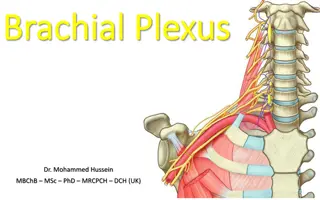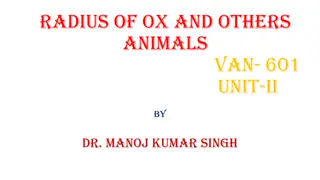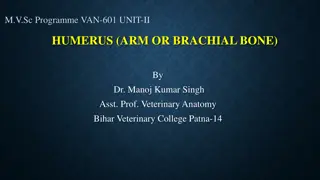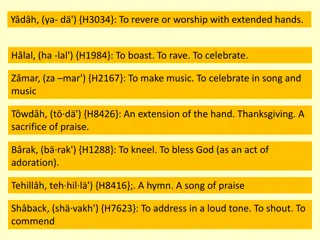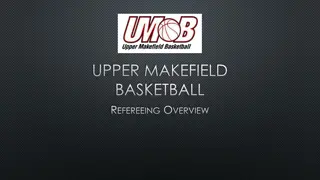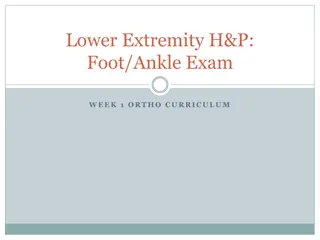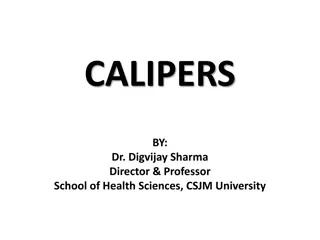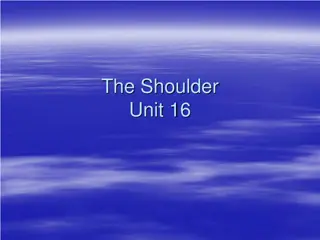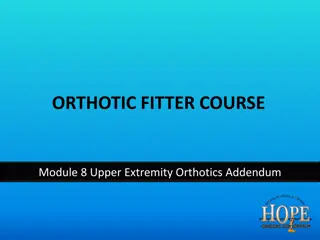Overview of Hands and Upper Extremity Conditions
This informative content covers various hand and upper extremity conditions including nerve innervation, deformities, splints, and syndromes such as carpal tunnel syndrome and cubital tunnel syndrome. It discusses key nerves like the ulnar, median, and radial, their functions, associated deformities, and appropriate splinting techniques. Additionally, it touches on conditions like Ape Hand deformity, Wrist Drop, Claw Hand, and Carpal Tunnel Syndrome, along with interventions and provocative tests.
Download Presentation

Please find below an Image/Link to download the presentation.
The content on the website is provided AS IS for your information and personal use only. It may not be sold, licensed, or shared on other websites without obtaining consent from the author.If you encounter any issues during the download, it is possible that the publisher has removed the file from their server.
You are allowed to download the files provided on this website for personal or commercial use, subject to the condition that they are used lawfully. All files are the property of their respective owners.
The content on the website is provided AS IS for your information and personal use only. It may not be sold, licensed, or shared on other websites without obtaining consent from the author.
E N D
Presentation Transcript
Hands and Upper Extremity Conditions
Nerves What are the three nerves that innervate the hand? Ulnar, Median, Radial What is the Function of each these nerves? Median-dexterity Ulnar-power Radial- wrist extension What digits do each of the three nerves innervate?
Median Nerve What type of deformity would you see with a Median nerve injury? Ape Hand deformity What type of splint? C-bar or short opponens splint
Ape Hand Deformity Important: Thenar wasting
Radial Nerve What type of deformity would you see with a Radial nerve injury? Wrist drop What type of splint? Dynamic wrist extension splint or volar splint.
Ulnar Nerve What type of deformity would you see with a Ulnar nerve injury? Claw Hand What type of splint? MCP dorsal blocking splint
Claw Hand vs. Hand of Benediction Claw Hand: MCP hyperextends Hand of Benediction: Loss of flexors due to the median nerve injury. I.E. unable to composite full fist.
Carpal Tunnel Syndrome What nerve is involved? Median nerve What type of splint is involved? Volar splint with wrist in neutral What interventions would you include? Activity modification, median nerve glides, tendon glides, scar sensitivity, edema management What type of pain is associated with CTS? Pillar pain Source of pain is unknown
Provocative test associated with with CTS Tinel and Phalen s test
Cubital Tunnel Syndrome What nerve is involved? Ulnar What type of splint is involved? Long-arm splint What type of interventions would be included? Activity modification, Ulnar nerve glides, tendon glides, scar sensitivity, edema management Provocative test? Tinel
Radial Tunnel Syndrome What nerve is involved? Radial What type of splint is involved? Long arm splint What type of interventions would be included? Activity modification, radial nerve glides, tendon glides, scar sensitivity, edema management What position do you want to avoid? Forceful wrist extension and supination
Rheumatoid arthritis vs osteoarthritis Rheumatoid arthritis Autoimmune disorder that attacks body s own tissue Splint: Volar in extension splint Intervention: Education and activity modification Osteoarthritis The most common type is CMC arthritis Splint: Thumb spica Interventions: Activity modification, web-space stretching, first dorsal interosseous strengthening
Lateral Epicondylitis (Tennis Elbow) What tendon is involved with this injury? extensor carpi radialis brevis. Overuse of the wrist extensors What interventions are involved? Ice/deep friction massage, stretching, activity modification, ultrasound.
Medial Epicondylitis (Golfers elbow) What tendon is involved with this injury? Flexor-pronator Less common than lateral epicondylitis What interventions are involved? Ice/deep friction massage, stretching, activity modification, ultrasound.
De Quarvans What tendons are involved? Abductor pollicis longus and extensor pollicis brevis What type of splint is involved? Thumb spica or forearm thumb spica. What interventions are involved? Gentle ROM, tendon gliding, scar management, grip and pinch (when cleared by MD.) Provocative test: Finkelstein test
Trigger Finger What is the most common pulley associated with this injury? A1 Pulley Splint involved? MCP extension splint Interventions associated with injury? Edema control, tendon gliding, activity/work modification
Question 1 A patient who has rheumatoid arthritis is referred to OT for a functional splint to manage swan neck deformities. The type of splint indicated would be a: A.)buddy strap on the adjacent finger B.)short splint, to slightly flex the PIP C.)gutter splint D.)spring wire, to fully extend the PIP
Question 2 An OTR receives a referral requesting a short opponens splint for a patient who has a radial nerve injury. When the patient arrives for therapy, the OTR should FIRST: A.)screen for sensory and motor deficits in the involved extremity contact the referring physician to question the need for the requested splint fabricate a long opponens splint fabricate the prescribed splint for the patient
Question 3 To rule out de Quervain s tenosynovitis, the OTR would have the patient: A.)stabilize the wrist when resistance is applied to the ulna B.)flex the wrist fully and maintain the position for one minute C.)apply resistance to the radially deviated and extended wrist D.)make a fist with the thumb inside the fingers and ulnarly deviate the wrist
Question 4 A patient who has wrist tendonitis that is aggravated by work duties is approved for four OT visits, including the initial evaluation. To be most efficient in meeting the goal of reducing pain secondary to job performance, the home program should include: A.)icing, stretching, and activity modification B.)active ROM, eccentric exercises, and joint protection C.) heat, splinting, and forearm muscle strengthening D.) cold packs, forearm muscle strengthening, and repetitive grip exercises
Question 5 The sequence of graded treatment techniques that would most benefit a patient who has an acute exacerbation of rheumatoid arthritis is: A.)isotonic muscle strengthening, desensitization, ADL B.)active ROM, joint protection, splinting C.)aerobic exercises, active ROM, splinting D.)aquatic exercises, muscle strengthening, joint protection
Question 6 Prior to initiating a functional activity, the most effective method of reducing edema in a patient who has persistent swelling and decreased function 8 weeks after a distal radius fracture is: A.)elevation, passive motion, and hot packs B.)active and passive motion, and paraffin C.)active and passive motion, and whirlpool D.)elevation, active motion, and contrast bath
Question 7 A patient who had recent onset of carpal tunnel syndrome is referred to OT. The OTR would issue a volar splint to: A. limit wrist motion B. improve leverage for grasping C. increase ROM of the fingers D. decrease edema in the hand
Question 8 A patient who has had an amputation of the fingertips has moderate hypersensitivity. When working on desensitization, the OTR should advise the patient to immerse the hand in particles: A.)that range from least irritating to most irritating B.)that do not cause any form of discomfort C.)according to a standardized protocol D.)that cannot be identified with vision occluded
Question 9 The best method for evaluating hand edema in a patient who has an infected open wound of the palm is by: A.)drawing sequential hand outlines B.)measuring hand circumference at the level of the MCP joints C.)performing volumetric measurements D.)recording the distance from the fingertip to the distal palmer crease
Question 10 A patient who is right-hand dominant has a right high-level radial nerve injury following a humeral fracture. The splint that would maximize functioning of the involved hand during recovery would provide: A.)static wrist support B.)dynamic assist of finger extension C.)dynamic blocking of lumbricals D.)static wrist support and C-bar attachment
Question 11 An OTR completes a work site evaluation for a secretary who has developed bilateral carpal tunnel syndrome. The OTR notes that the secretary s work area has poor ergonomic design. To reduce the risk factor associated with the patient's symptoms, the OTR should recommend: A.)semi flexible splints to reduce abnormal wrist postures B.)using a chair with arm rests so that arms are supported C.)adjusting the computer table height so that the elbows are flexed at 45 degrees D.)placing the computer keyboard in a position so that wrists are neutral
Question 12 A short opponens splint is for muscle weakness resulting from injury to the: A.) ulnar nerve at elbow level B.)radial nerve at the elbow level C.)median nerve at wrist level D.)ulnar nerve at wrist level
Question 13 An adult patient who has a radial nerve compression at the humeral level of the dominant upper extremity reports multiple problems with ADL. The initial OT intervention would be to: A.) fabricate a forearm-based orthosis that provides dynamic wrist and finger extension B.) enlarge handles on all tools for ADL C.)apply a prefabricated short opponens splint to improve prehension patterns D.)train the patent to use one-handed techniques
Question 14 An individual who has rheumatoid arthritis has mild ulnar drift in the fingers. To minimize further deformity, the OTR should instruct the individual to: A.)pick up a coffee mug by the handle B.)push up from a chair with flexed fingers instead of open palms C.)open jars by utilizing the palm and turning in a radial direction D.)use lateral pinch instead of fingertip pinch to pick up objects
Question 15 Protraction (Hunching) of the shoulders is caused by what muscle tightness? A.)Pec major, pec minor, serratus anterior B.) Pec major, scapula, pec minor C.) Pec major, triceps, clavicle
Question 16: Which muscle is the strongest wrist extension? A.) Extensor carpi radialis brevis B.) Extensor indicis C.) extensor carpi radialis longus
Question 17 An OTR receives an order to work on a nonresistive exercise program with a patient who had a shoulder fracture 2 weeks ago. Initial OT treatment should include: A.)pendulum exercises B.)active ROM C.)weight bearing exercises D.)isotonic strengthening
Feedback Ortho Bullets





